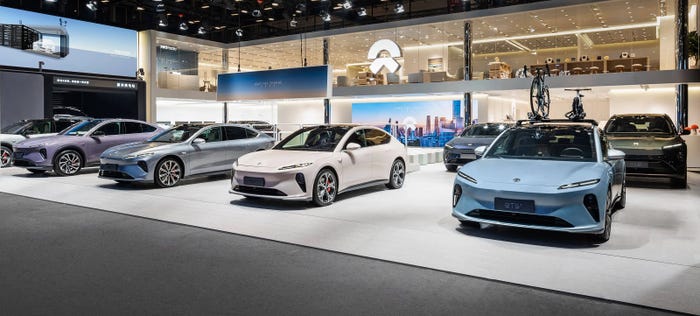A bright future in the automotive industry requires stellar know-how and cutting-edge engineering excellence
The automotive industry is on the cusp of a dynamic shift: an evolution from predominantly electromechanical cars to smart, adaptable mobile electronic platforms capable of continuous upgrades, aka software-defined vehicles – SDVs. Previously dominated by hardware, now software is shaping vehicles in terms of operation, personalization, and interaction with the wider world.
May 13, 2024

Sasken has defined, developed, and delivered emerging automotive electrical/electronics technologies for over a decade. The race to the top stands on a strong foundation.
“I’d say what sets us apart is our deep-rooted product development experience. We've pioneered in the realm of connectivity, from 2G to the current 5G. Our pedigree has equipped us with invaluable knowledge, making us a trusted partner for some of the biggest names in the industry,” notes Jaimir Singhvi, VP & Head of Sales, Automotive & industrial at Sasken.
We are looking at a rapidly transforming sector and technology. Increasingly, manufacturers are taking the reins, developing their own software. The desire? More control and understanding of the software within vehicles. This is where Sasken can play a crucial part as a provider of critical SDV components.
Pioneering Connectivity: A Competitive Edge
Modern vehicles are transitioning from having disparate, individual control units to centralized systems with High-Performance Compute controllers, specifically the digital cockpit and the body domain controller. The digital cockpit manages various functionalities like the infotainment system, navigation, head-up display, and rear seat entertainment, all from one unified control center. The body domain controller oversees vehicle safety, access control, lighting, and other driver preferences.
“Staying at the cutting edge is crucial for us. That’s why we’ve recently joined SOAFEE SIG, which is leading the charge in standardizing modular vehicular architectures that enable cloud technologies to be combined with automotive functional safety and real-time requirements,” adds Shantanu Das, Chief Architect- Automotive at Sasken.
“Our expertise is both diverse and deep. Firstly, we excel in the field of telematics, with a particular emphasis on 4G and 5G integration. Our second forte is the infotainment realm and development of the digital cockpit, especially in Android-based systems. Our third strength is in the domain of body electronics software. Lastly, we are adept at automotive digital engineering, cementing our capabilities across these four pivotal tech domains,” Singhvi summarizes.
By collaborating with leading cloud service providers like Google, AWS, and Microsoft, Sasken is well-equipped to craft bespoke cloud services.
“In addition, as a company we have a unique combination of connectivity and automotive experience and this is supported by a strong team skilled in various connectivity experiences: Bluetooth, Wi-Fi, NFC, smartphone mirroring technologies,” Singhvi notes.
Early adoption and partnership with leading platform vendors such as Qualcomm have given Sasken a competitive edge.
“Another one of our strengths lies in end-to-end testing. We offer an in-house testing accelerator called "KenTest." This tool facilitates end-to-end validation for complex systems, ensuring that every component, from cloud to connectivity, performs optimally,” Das mentions.
With vehicle increasingly resembling computers on wheels, cybersecurity is a key concern and needs to be addressed with due diligence. This is especially true with telematics devices hosting numerous applications using varied communication channels. For Sasken, ensuring robust cybersecurity measures is of key concern, and strict protocols are adhered to.
“Our channels are fortified: we've embedded firewall mechanisms in the vehicle network, preventing interference between different communication channels. We deploy the TEE to execute software that's crucial for operations and could prove vulnerable, isolating it from other software,” Das ensures.
One common cyberattack method involves overwriting existing software.
“To counter this, we've implemented a secure boot system, ensuring unauthorized software can't be installed on our ECUs. For external communications, we leverage Transport Layer Security (TLS) – like the secure connections used in HTTPS. This ensures data packets sent from the vehicle are encrypted and unreadable by third parties while enroute to their destination,” Das explains.
Another security feature is prioritizing over-the-air software updates with Secure Firmware Over-The-Air (FOTA) system. This involves multiple nodes, each responsible for validating its own security.
Looking forward – complexity, 5G, SatCom and a longer lifespan
The automotive world is evolving rapidly. As mentioned, vehicles are becoming more and more reliant on software. One of the advantages for the end-user is that frequent software updates can extend a vehicle's lifespan – a trend that fits well into the all-encompassing sustainability paradigm. As we’ve seen in Europe, the future of automotives is electric.
“With the introduction of High-Performance Compute (HPC) systems in vehicles, there's a surge in power requirements. Electric vehicles, with their larger battery capacities, seem to be better equipped to handle this transition”, Das pinpoints.
The electric vehicle market worldwide is seeing significant growth. This is thanks to a combination of global emission mandates, local incentives, the expansion of charging infrastructure, and a wider variety of EVs available to consumers. World-renowned automotive companies such as Volkswagen Group, AUDI, Porche, BMW, and Mercedes-Benz are investing heavily in R&D, and there is a significant emphasis on integrating software solutions for enhanced vehicle performance, safety, and user experience.
“Today consumers have high expectations when it comes to the quality and performance of vehicles. As software becomes a defining factor in vehicle performance, consumer expectations around software reliability, features, and updates become crucial. This is where Sasken can help,” Jaimir Singhvi notes.
Another all-encompassing trend is connectivity, 5G especially, which is shaping the future of telematics. Virtual testing and cloud-based vehicle functions are becoming more prevalent, enabling development and testing in virtual environments before real-world implementation.
As the automotive world embraces 5G and connectivity, developments in Advanced Driver-Assistance Systems (ADAS) and Vehicle-to-Everything (V2X) communication promise revolutionary changes.
“Satellite connectivity in the automotive sector is an exciting trend, given our own cutting-edge expertise in satellite communications. It’s an intriguing future and we’re fully equipped to take advantage of the possibilities," Das states.
You May Also Like




